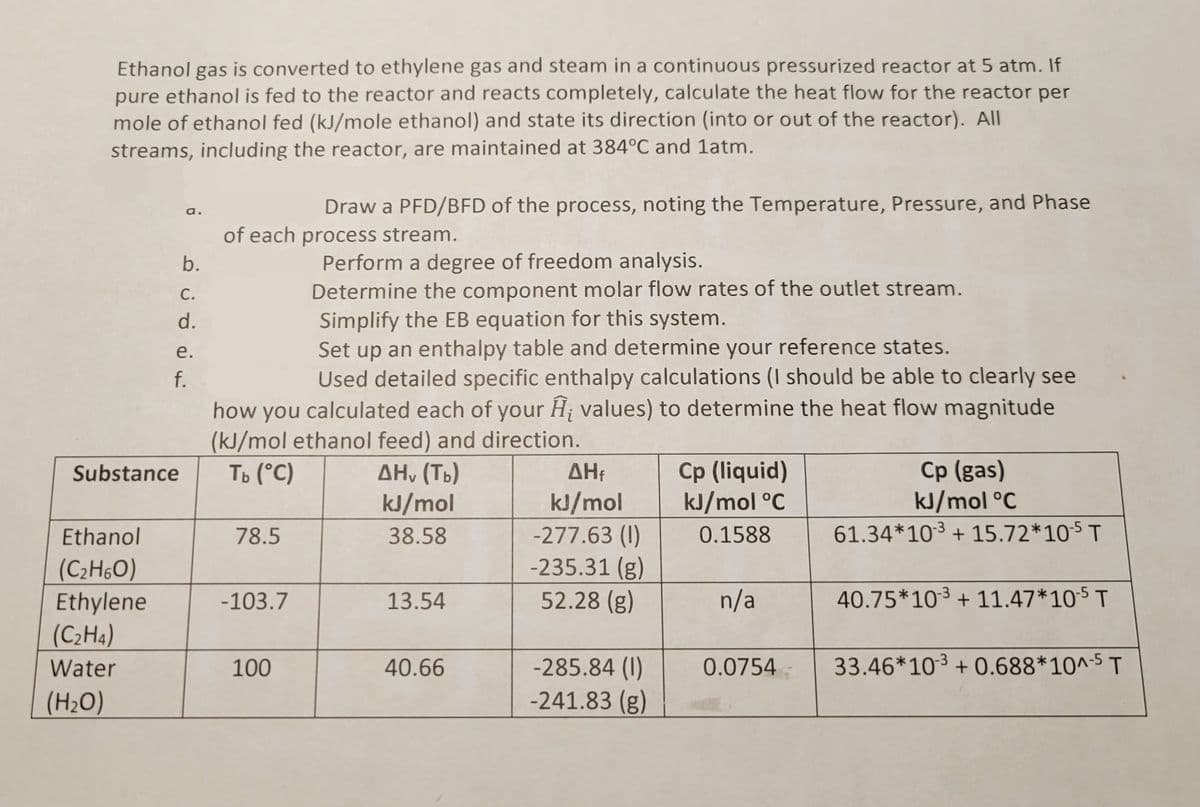Ethanol gas is converted to ethylene gas and steam in a continuous pressurized reactor at 5 atm. If pure ethanol is fed to the reactor and reacts completely, calculate the heat flow for the reactor per mole of ethanol fed (kJ/mole ethanol) and state its direction (into or out of the reactor). All streams, including the reactor, are maintained at 384°C and latm. Ethanol (C₂H60) Ethylene (C₂H4) Water (H₂O) a. Substance b. C. d. e. f. Draw a PFD/BFD of the process, noting the Temperature, Pressure, and Phase of each process stream. Perform a degree of freedom analysis. Determine the component molar flow rates of the outlet stream. Simplify the EB equation for this system. Set up an enthalpy table and determine your reference states. Used detailed specific enthalpy calculations (I should be able to clearly see how you calculated each of your A values) to determine the heat flow magnitude (kJ/mol ethanol feed) and direction. Tb (°C) AH, (Tb) 78.5 -103.7 100 kJ/mol 38.58 13.54 40.66 ΔΗ, kJ/mol -277.63 (1) -235.31 (g) 52.28 (g) -285.84 (1) -241.83 (g) Cp (liquid) kJ/mol °C 0.1588 n/a 0.0754 Cp (gas) kJ/mol °C 61.34*103+15.72*105 T 40.75*103 + 11.47*10-5 T 33.46*10-3+0.688*10^-5 T
Ethanol gas is converted to ethylene gas and steam in a continuous pressurized reactor at 5 atm. If pure ethanol is fed to the reactor and reacts completely, calculate the heat flow for the reactor per mole of ethanol fed (kJ/mole ethanol) and state its direction (into or out of the reactor). All streams, including the reactor, are maintained at 384°C and latm. Ethanol (C₂H60) Ethylene (C₂H4) Water (H₂O) a. Substance b. C. d. e. f. Draw a PFD/BFD of the process, noting the Temperature, Pressure, and Phase of each process stream. Perform a degree of freedom analysis. Determine the component molar flow rates of the outlet stream. Simplify the EB equation for this system. Set up an enthalpy table and determine your reference states. Used detailed specific enthalpy calculations (I should be able to clearly see how you calculated each of your A values) to determine the heat flow magnitude (kJ/mol ethanol feed) and direction. Tb (°C) AH, (Tb) 78.5 -103.7 100 kJ/mol 38.58 13.54 40.66 ΔΗ, kJ/mol -277.63 (1) -235.31 (g) 52.28 (g) -285.84 (1) -241.83 (g) Cp (liquid) kJ/mol °C 0.1588 n/a 0.0754 Cp (gas) kJ/mol °C 61.34*103+15.72*105 T 40.75*103 + 11.47*10-5 T 33.46*10-3+0.688*10^-5 T
Introduction to Chemical Engineering Thermodynamics
8th Edition
ISBN:9781259696527
Author:J.M. Smith Termodinamica en ingenieria quimica, Hendrick C Van Ness, Michael Abbott, Mark Swihart
Publisher:J.M. Smith Termodinamica en ingenieria quimica, Hendrick C Van Ness, Michael Abbott, Mark Swihart
Chapter1: Introduction
Section: Chapter Questions
Problem 1.1P
Related questions
Question
Can you please help me with part d

Transcribed Image Text:Ethanol gas is converted to ethylene gas and steam in a continuous pressurized reactor at 5 atm. If
pure ethanol is fed to the reactor and reacts completely, calculate the heat flow for the reactor per
mole of ethanol fed (kJ/mole ethanol) and state its direction (into or out of the reactor). All
streams, including the reactor, are maintained at 384°C and 1atm.
Ethanol
(C₂H60)
Ethylene
(C₂H4)
Water
(H₂O)
a.
b.
C.
d.
e.
Substance
f.
Draw a PFD/BFD of the process, noting the Temperature, Pressure, and Phase
of each process stream.
Perform a degree of freedom analysis.
Determine the component molar flow rates of the outlet stream.
Simplify the EB equation for this system.
Set up an enthalpy table and determine your reference states.
Used detailed specific enthalpy calculations (I should be able to clearly see
how you calculated each of your ; values) to determine the heat flow magnitude
(kJ/mol ethanol feed) and direction.
Tb (°C)
AH, (Tb)
78.5
-103.7
100
kJ/mol
38.58
13.54
40.66
AHf
kJ/mol
-277.63 (1)
-235.31 (g)
52.28 (g)
-285.84 (1)
-241.83 (g)
Cp (liquid)
kJ/mol °C
0.1588
n/a
0.0754
Cp (gas)
kJ/mol °C
61.34*10-3+15.72*10-5 T
40.75*103 + 11.47*105 T
33.46*10-3+0.688*10^-5 T
Expert Solution
This question has been solved!
Explore an expertly crafted, step-by-step solution for a thorough understanding of key concepts.
Step by step
Solved in 2 steps with 1 images

Recommended textbooks for you

Introduction to Chemical Engineering Thermodynami…
Chemical Engineering
ISBN:
9781259696527
Author:
J.M. Smith Termodinamica en ingenieria quimica, Hendrick C Van Ness, Michael Abbott, Mark Swihart
Publisher:
McGraw-Hill Education

Elementary Principles of Chemical Processes, Bind…
Chemical Engineering
ISBN:
9781118431221
Author:
Richard M. Felder, Ronald W. Rousseau, Lisa G. Bullard
Publisher:
WILEY

Elements of Chemical Reaction Engineering (5th Ed…
Chemical Engineering
ISBN:
9780133887518
Author:
H. Scott Fogler
Publisher:
Prentice Hall

Introduction to Chemical Engineering Thermodynami…
Chemical Engineering
ISBN:
9781259696527
Author:
J.M. Smith Termodinamica en ingenieria quimica, Hendrick C Van Ness, Michael Abbott, Mark Swihart
Publisher:
McGraw-Hill Education

Elementary Principles of Chemical Processes, Bind…
Chemical Engineering
ISBN:
9781118431221
Author:
Richard M. Felder, Ronald W. Rousseau, Lisa G. Bullard
Publisher:
WILEY

Elements of Chemical Reaction Engineering (5th Ed…
Chemical Engineering
ISBN:
9780133887518
Author:
H. Scott Fogler
Publisher:
Prentice Hall


Industrial Plastics: Theory and Applications
Chemical Engineering
ISBN:
9781285061238
Author:
Lokensgard, Erik
Publisher:
Delmar Cengage Learning

Unit Operations of Chemical Engineering
Chemical Engineering
ISBN:
9780072848236
Author:
Warren McCabe, Julian C. Smith, Peter Harriott
Publisher:
McGraw-Hill Companies, The